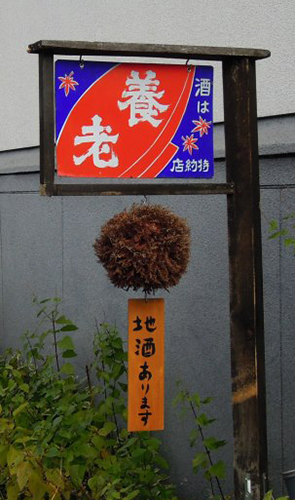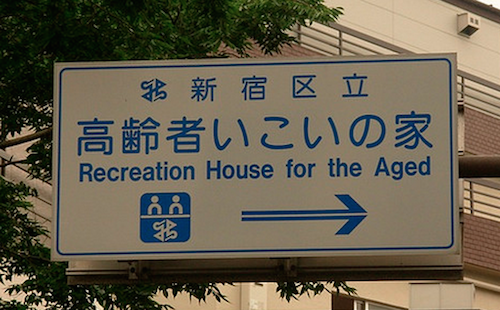125. The "Old" Radical: 老 and 耂
The "old" radical 老 contains a few surprises, but before I present those, let's cover the basics.
This six-stroke radical looks identical to the following kanji:
老 (609: old)
We can call this on-duty radical おい, which likely derives from 老い (おい: old age).
Our radical takes its variant form 耂 in two more Joyo kanji in which it is on duty:
考 (117: to think; study; examination)
者 (298: person; one)
The Japanese refer to the four-stroke variant as おいかんむり or おいがしら. Both -かんむり and -かしら (voiced as -がしら in the latter name) represent the third radical position, the top of a character. (To understand this more, consult "Radical Terms" and see the Radical Positions section.)
Nelson mentions ろう as another possible name for our radical, but my proofreader can find no evidence of that in his sources.
As for English names, "old" works, as does "old man."

Photo Credit: Yoshikazu Kunugi
In Yamanashi City (in Yamanashi Prefecture on Honshu), a saké brewery produces the saké brand 養老 (ようろう). The name literally means "nurturing the elderly." As 酒 (さけ) means "saké," 酒は養老 conveys this message: "If you drink saké, Yoro is your choice."
We need to read the other kanji compound on the sign from right to left as 特約店 (とくやくてん: special agent). This indicates that the shop is a special agent of the Yoro Brewery (which is not to say a spy!).
On the lower sign, the 地酒 (じざけ: local saké) combines with あります to mean "There is local saké (here)."
The brown object is a 杉玉 (すぎたま). Saké makers hang a fresh, green ball of cedar leaves outside to announce that a new brew of saké has been produced. As the ball becomes old and brown, the change in color reminds people that the saké is aging. For more on this, see essay 1467 on 杉 (cedar).
Etymologies
Now for the aforementioned surprises! According to Henshall in his newer edition, the ancient forms of 老 and 考 were virtually indistinguishable. The early shape showed "an aged and fragile person with (a) bent back and often with long hair, leaning on a stick," he says. Thus, the character symbolized "old person (with stick for support)."
In the bronze stage, the lower half of 考 changed to something closer to what we see today. This bottom component serves as a phonetic with the associated sense "bent over" or "old" (depending on which scholar you ask). Even after that transformation, the whole character still meant "old person." Subsequently, the ancient Chinese borrowed 考 to represent a homophone meaning "examine, consider."
As 者 primarily means "person," shouldn't that character also depict someone elderly? No, says Henshall. The bronze form shows "firewood projecting up out of a container." The wood could be burning. Originally, the shape meant "collect and store much firewood." The "person" definition is a loan usage.
So 老 and 考 originally represented a human but no longer do. And 者 symbolized firewood but came to mean "person"!

Photo Credit: Glennis Dolce
The word 高齢者 (こうれいしゃ) means "elderly person." Although 高齢 (こうれい) translates as "old age," those kanji don't contain the "old" radical. Meanwhile, 者 (person) does, though, again, that character has no connection to senescence.
The 家 (いえ) is "house," 新宿 (しんじゅく) represents "Shinjuku" (a section of Tokyo), and 区立 (くりつ) means "run by the ward."
